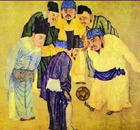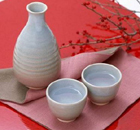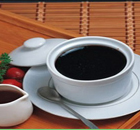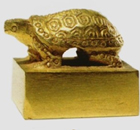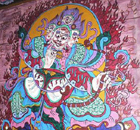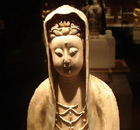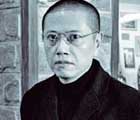Heritage
The Temple of Heaven (Beijing)
(chinaculture.org)
Updated: 2008-04-07 14:45
 |
Large Medium Small |
Brief Introduction
The largest existing complex of ancient sacrificial buildings in China; masterpiece of China's royal sacrificial buildings complex and one of the best symbolic illustrations of Chinese cosmology.
Located in the southern part of Beijing, the Temple of Heaven (Tiantan) has been one of the most sacred places for the whole country for more than five centuries. It served as a complex of sacrificial buildings for the Ming and Qing emperors, and is the largest one in Beijing among several royal altars to Heaven, Earth, the Sun, the Moon and other deities or symbolic forces of Nature.
Cultural Heritage
The Temple of Heaven was built in 1420 during the reign of Emperor Yongle of the Ming Dynasty (1368-1644), originally as an altar for the worship of both Heaven and Earth. It began to serve as the exclusive imperial altar for Heaven and the Harvest since the worship of Heaven and Earth was divided in 1530, and a new Altar of Earth was built in the northern part of the capital.
In the overall layout and individual designs of its buildings, the Temple of Heaven symbolizes the relationship between Earth and Heaven which stands at the heart of Chinese cosmogony, and also the special role played by the emperors within that relationship.
Surrounded by an outer wall of 5 km, it covers an area of 273 ha, thrice the size of the Forbidden City. It is divided into the Inner Temple (Neitan) and the Outer Temple (Waitan) by a double wall.
The main buildings of the Inner Temple are on a north-south axis, including the Circular Mound Altar (Huanqiutan) in the south and the Altar of Prayer for Good Harvests (Qigutan) in the north. The two altars are connected by a brick and stone walkway named Shendao (Sacred Road), an allusion to the long road to the imperial court. The Outer Temple consists mainly of age-old pinewoods, cypresses and the Department of Sacred Music (Shenyueshu), of which only half remains.
Architecture
In architecture the entire design is symbolic. The southern part of the Inner Temple is square, while the northern part is semi-circular, a pattern representing the ancient belief that Heaven is round and Earth square. The northern wall was built higher than the southern wall, illustrating the notion of Heaven surpassing Earth. Compared to the imposing complexity and intricacy of royal palaces, the altar area here is simple, setting off the vastness of the sky, and the grandeur of Heaven.
In ancient China, odd numbers were regarded as heavenly or as related to the sun. Since nine was considered the most powerful of all numbers, the altar, a three-tiered terrace, was constructed with rings of stone slabs in multiples of nine, and the steps and balustrades are also in multiples of nine. At the center of the top terrace lies a round stone known as the Center-of-Heaven Stone (Tianxinshi), which has an amplifying impact for speeches made from it.Three major structures of the altar, namely the Circular Mound Altar (huanqiu), the Imperial Vault of Heaven (huangqiongyu) and the Hall of Prayer for Good Harvests (qiniandian) all have round floors and roofs, in accordance with the concept of round Heaven. Deep-blue tiles were chosen to cover these structures so as to harmonize with the blue sky.
The Circular Mound Altar, also known as the Altar for Worshiping Heaven (Baitiantai) or the Sacrificial Altar (Jitai), is the place where the emperor worshiped Heaven at the winter solstice. The Imperial Vault of Heaven is the place where the tablets of the gods were kept, surrounded by a circular wall of polished bricks, known as Echo Wall (huiyinbi), where a person whispering close to the wall at any point can be heard distinctly at any other point along the wall.
In the northern part of the temple, the Hall of Prayer for Good Harvests is a lofty, round structure with triple eaves and a cone-shaped blue-tile roof crowned with a gilded knob. When the hall was built in 1420, the colors of the triple eaves, from top to bottom, were blue, yellow and green, representing the God of Heaven, the emperor, and the common people. In 1752, all the eaves were painted blue. The hall burned down in 1889 after being struck by lightning. It was reconstructed in 1890 and renovated in 1970.
The ceiling of the Hall of Prayer for Good Harvests is painted with an exquisite design of nine dragons, and is supported by 28 wooden columns. The four central columns, called the Dragon-Well Columns, represent the four seasons. They are surrounded by two rings, one inside the other, of 12 columns each. The inner ring symbolizes the 12 months of the year, and the outer, the 12 divisions of day and night according to the old Chinese way of reckoning time. Every year, the emperor led civil and military officials to the hall and prayed for good harvests.
Designed with distinctive compactness and exquisiteness, and decorated magnificently, the Temple of Heaven is a building complex of a beauty rare even among the sacrificial buildings in China and a valuable part of the architectural heritage of the world.
Sacrificial Culture
Sacrifices to Heaven were arranged in winter every year. On the 15th day of the first lunar month, on the winter solstice (22nd solar term), and some time during the first month of summer, the emperor would go to the Temple of Heaven to worship Heaven, to pray for good harvests and rainfall, and to offer sacrifices to the ancestors, to the gods of the sun, the moon and the stars, and to the gods of the clouds, wind, rain, and thunder and lightning.
Sacrificial ceremonies followed complex procedures. First, the whole altar area had to be renewed from end to end, including the roads to be taken by the emperor. Second, the sacrifices, including oxen, goats, piglets, fruits, etc., had to be properly prepared and displayed in front of seven groups of spirit tablets. In addition, 700-odd items of utensils and other sacrificial facilities, as well as more than 60 musical instruments of 16 kinds, including bells and chimes, had to be placed in order. Third, one day before the formal ceremony, the emperor was obliged to burn joss sticks in the Imperial Vault of Heaven, to check the spirit tablets in the Circular Mound Altar, to examine the sacrifices in the sacred kitchen, and to begin fasting in the Palace of Abstinence.
The ceremony began before sunrise. The emperor proceeded from the Palace of Abstinence, amid the sound of bells, to the Circular Mound Altar, when drums and other instruments took the place of the bells. At the formal opening of the sacrificial ceremony, oxen were roasted, lanterns were raised, and a mystical aura would soon cloak the scene. The whole ceremony was divided into nine procedures -- from receiving the Heavenly King to seeing Him off. Different music would accompany different parts of the ceremony.
Every sacrificial ceremony was a grand occasion to solicit welfare for the country, as well as respect and awe from the people towards the emperor, who was sanctified as the Son of Heaven (Tianzi) throughout ages.
